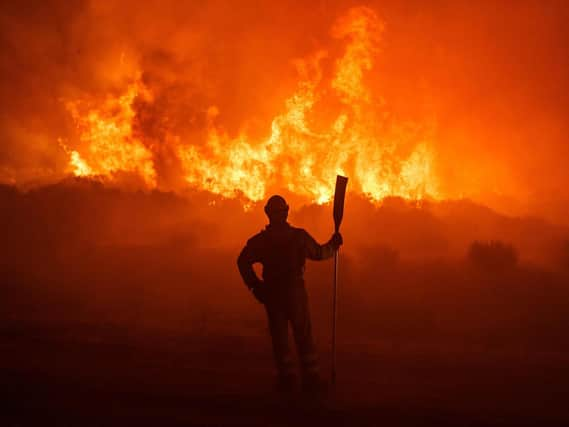Readers' letters: We must have action to tackle emergency


It said we are changing the planet in “unprecedented and sometimes irreversible ways”.
In a year in which we have seen record-breaking heatwaves, floods and wildfires around the world, it’s becoming increasingly clear that action on climate change is no longer just about protecting future generations.
Advertisement
Hide AdAdvertisement
Hide AdBut we are seeing a failure of leadership to tackle climate change at every level.
Our national government has pledged to be net zero by 2050, but is allowing plans for new coal fields in Cumbria and new oil fields off the Shetlands to continue, against recommendations from the International Energy Agency.
Locally, we had large public demonstrations in September 2019, including several local schools “striking for the climate”, leading our council (Chorley Council) to declare a climate emergency and pledging to be a net zero borough by 2030.
As we approach two years since the council declared this emergency – two years out of only a decade in which we need to transition our energy, our business, our homes and our land – we have yet to see an overall plan for how the council will achieve this.
Locally and nationally, targets are not enough.
Advertisement
Hide AdAdvertisement
Hide AdWe need proactive leadership and decisive action to avert the IPCC’s worst case scenarios.
Andy Hunter-Rossall
Chorley Green Party
gratitude
Thank you for caring for son
My 51-year-old son has suffered from epilepsy since he was 18 and, as he falls without any warning, he has had many injuries.
The latest fall caused a bad fracture to his ankle. This involved plates and pins being inserted.
After two weeks in hospital, we were contacted by the Home First team at the hospital who asked to bring him home and assess his living arrangements. On inspection, it became obvious that it would be difficult for him to manage as he is 6ft 3in and his shower is quite small.
Advertisement
Hide AdAdvertisement
Hide AdHe returned to hospital while other arrangements could be made.
As this is the first time we have been involved with any outside agency and have always managed ourselves, this was quite stressful, both to my wife who was awaiting replacement knee surgery and myself.
It was decided that they would look for temporary rehab accommodation for him in the local area.
It was with some trepidation that the only place they could find that was willing to take someone with epilepsy was a care home that specialises in care for patients with dementia.
Advertisement
Hide AdAdvertisement
Hide AdSo the following day he was taken to Lostock Lodge care home in Lostock Hall.
From the first day it was a complete eye-opener.
The manager, Anita, and all of the staff were fantastic.
They were professional and caring, making sure he was comfortable and took control of his medication.
We were allowed to visit in the garden whenever we wanted and had coffee and biscuits with him.
He played dominoes with one lovely lady and was even included when the staff had a takeaway.
Advertisement
Hide AdAdvertisement
Hide AdAfter being there for five weeks, he has now returned home and is walking further every day.
My wife has also had her new knee and is progressing well.
So a big thank you to everyone at Lostock Lodge.
You were great.
Terry Casey
via email
development
Unanswered questions
Where’s the new vision for Lancaster’s development?
Lancaster and its council is facing a decision which may transform Lancaster into a new town, hardly recognisable from how it is now.
This is the proposal to develop around 9,000-plus houses to the south of the city, embracing the Bailrigg Garden Village and moving Junction 33 of the M6.
While many might welcome some further development to the south, the implications of such a massive build and the infrastructure required, further road schemes, health care, education are daunting.
Advertisement
Hide AdAdvertisement
Hide AdThere have been a number of consultations, the most recent last week.
However, these consultations, informed by Lancaster council officials, have added little to my and others’ understanding.
The core questions remain unanswered:
1. Do we want a ‘new town’ between Lancaster and Galgate, increasing the size of Lancaster by approximately 50 per cent, and is it feasible?
2. What is the demand for these houses, where are the incoming residents expected to work and what does that imply for the road system?
Advertisement
Hide AdAdvertisement
Hide Ad3. Where is the proposed road infrastructure from the new town into the city and how will it be funded? How will the obvious bottlenecks be opened up?
4. How can such a large housing and road development be compatible with the climate crisis, the city council’s declaration of climate emergency and the need to cut emissions to zero over the project’s life?
In addition, there are many subsidiary questions concerning the health and educational services that would be needed and how these are to be organised and financed: local residents will need reassurance that any financial risk will not fall on council taxpayers.
The overwhelming impression from the consultations is that, as yet, there is no convincing vision of what Lancaster will look like by 2035 beyond that of a new motorway junction and a very large housing estate.
The proposals need to be rethought from square one and the funding for the new junction postponed or rejected.
Robert Fildes
Scotforth
Comment Guidelines
National World encourages reader discussion on our stories. User feedback, insights and back-and-forth exchanges add a rich layer of context to reporting. Please review our Community Guidelines before commenting.